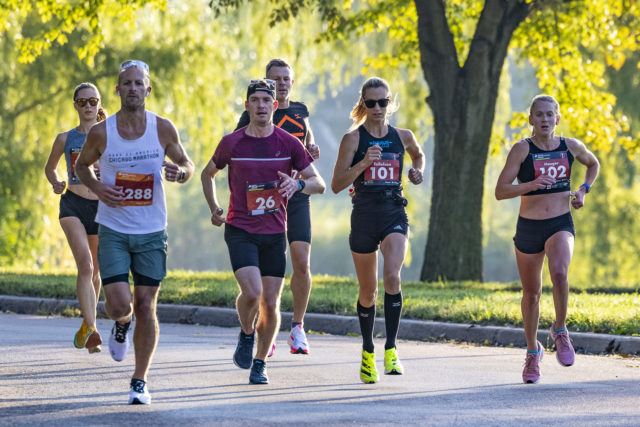Without a top shelf professional elite field at the 2021 Medtronic Twin Cities Marathon, the focus was all local this fall.
The pandemic-prompted change for the event, which typically draws top elite runner talent lured by an attractive professional prize purse, allowed Twin Cities in Motion (TCM) to experiment with creative concepts for documenting on-course action and producing a post-race recap.
In a normal year, a lead vehicle with a commentator providing live updates on moves within the field would share the play-by-play for broadcast at the finish line. But this year, that aspect was absent.
“In some ways this reminded me of races before there was prize money and before this wonderful sport of ours evolved into all the things it has become today,” said Charlie Mahler, senior media and communications manager for Twin Cities in Motion. “There was a different story this year. So, we asked ourselves: how do we tell it?”
The answer was to adopt a bit of a DIY (do it yourself) approach. That started way before race day, when top runners for the seeded event were registering. To get to know their top local athletes, TCM asked them to answer questions on self-recorded video.
“It’s an overused phrase, but it would mean the world,” said Charlie Lawrence, who finished second in the marathon. “I’m a Minnesota kid, grew up running for the Gophers, I’ve run thousands of miles on River Road and around the lakes, up Summit, as well as downtown Minneapolis.” He goes on to share his three Minnesota-themed tattoos.
“I’m really excited to get back out there with this community that I love so much,” said Olympian Carrie Tollefson, a running legend in the state. “Minnesota has been home for me. And you have all stuck with me, and cheered for me, and given me such support. I love what the Medtronic Twin Cities Marathon is all about.”
The approach had a dual purpose: it helped develop storylines for local media outlets, and it also provided B-roll for the post-race recap video, to be shown at the finish line festival.
Another concept incorporated into that video was crowd-sourced video collected along the course as runners were completing their races. This turned out to be more challenging than anticipated.
“In the end, we pulled back from having just anyone do that and reached out to some of our course marshals and sponsored fluid stations to have them record video and plug that into the show at different times,” Mahler said. “It’s certainly a way to contain costs, so you’re not paying for a camera out there.” He plans to come back to the concept for the race’s 40th edition in 2022 in the hopes of fully nailing the execution.
Meanwhile, back at the finish line, race announcer Kris Swarthout took the DIY concept to heart. After the runners had started their race, he ran home and turned on his desktop, where he used the same timer tracking technology friends and families were using to track their favorite runners to commentate real time on the action happening on course.
But first, he made a quick stop at the restroom to start the broadcast – it was the only place he could find a crowd of people.
“They were definitely wondering, who is this creepy guy holding up his phone and talking via Zoom,” Swarthout laughed. A professional endurance coach with a passion for sports of all kinds, he borrowed approaches from both the U.S. Open and Tour de France in his ongoing live report.
There were a few challenges, though. “We had some people who were unseeded but ended up being very good. So, I was actively Googling to see who they were and what their past successes had been.” He also introduced the largely recreational audience to some terms they might not have known – like rabbits, drafting, and using tangents.
“The key is to add flavor, be punchy, make it quick and always be excited,” noted Swarthout. “It was really fulfilling to be able to contribute to the event in a way that I hadn’t previously, and it added something to the broadcast that made it more well-rounded.”
He was also able to tell the stories of people like Carrie Tollefson. “She is Minnesota embodied in a human being,” he observed. “But you see when she’s out there on the course that she’s tapping back into her Olympic DNA. I talked about the challenges of being a runner and being a mom. That seemed to resonate with people more than just standard announcer copy.”
Completing the local celebration were the crowds of spectators that came out to cheer for runners along the course. They’re a Twin Cities tradition and seemed more enthusiastic and omnipresent than ever this year.
“What people say when they run our race for the first time is ‘this is a beautiful race, and there are just people everywhere,’” Mahler said. Even on relatively anonymous stretches of the course, people line up to cheer.
He continued: “They come out of the neighborhoods, because after the course leaves downtown, it’s in the neighborhoods really the whole way. That’s going on a 40 year tradition for us, that was interrupted for a year. And that probably brought more people out.”

